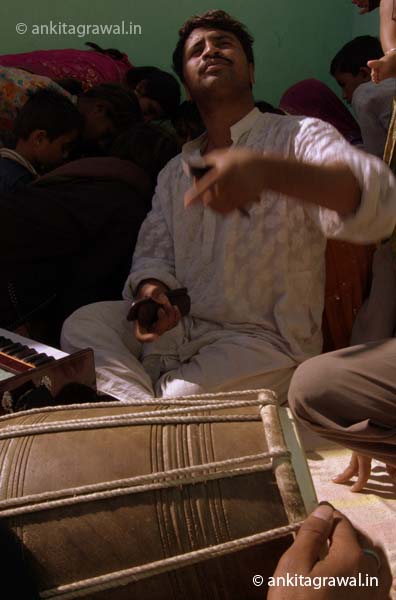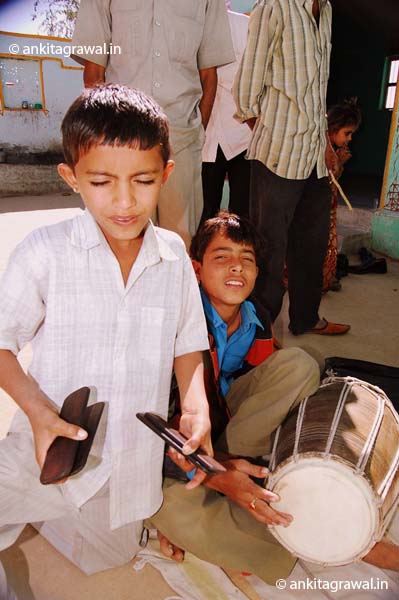Status of Manganiyars

Ustad Roshan Khan doing Riyaz at his home in Dedadiyar, Rajasthan.
Manganiyar is a Muslim singing community of western Rajasthan which sings songs on the occasions of birth of boy, death, marriage, pregnancy, love, festivals, respect and sufi songs for their Hindu Rajputpatrons. The word ‘Manganiyar’is derived from ‘one who begs’ but this connotation is no more true today. This community is mainly found in Jodhpur, Jaisalmer and Barmer districts of Rajasthan and a small number also live in Sindh, Pakistan and southern district of Jallore, where they call themselves Mirasi. It is an honorific term used for all Muslim professional singers, hence they can also be called Mirasi.
Komal Kothari, a researcher and folklorist on Rajasthani traditions defined Manganiyars as “Professional hereditary caste musicians whose relationship with their Rajput patrons is based on Jajmani system i.e. their services are linked with religious functions involving the genealogy of the patron’s family and conducting different ceremonies, both social and religious.”
This patronage system is very interesting as Gulab Khan, a Manganiyar singer and police constable posted in Barmer says, “After father’s death, we divide jajmans equally among ourselves like property. This applies to our Patrons too, whose sons are obliged to continue supporting our families. Even if one of us cannot sing, the patrons give them neg, a fixed amount of money. This support is also extended on the personal front such as expenditures during other needs like festival, marriage, birth, death.”
Manganiyar community is full of astonishing features. This community is more or less illiterate but it has impressive memorizing power. At any time, a Manganiyar singer can recite thousands of poems by sufi saints like Baba Bulle Shah, Shah Latif, Amir Khusro, Jalal ud-din Mohammad Rumi and also Indian saints like Kabir, Meera, Ravidas. Nobody teaches them, these things but they memorize it through the Shrut, listening, way of learning, listening. Roshan Khan, a Manganiyar singer recalled “When government tried to teach their children, children started doubting their memory skills.”
Unlike Indian classical music, Manganiyars do not have any gharana or ‘guru shishya parampara’. For Manganiyars, music is like mother tongue. They learn without a teacher. This is the reason kids start singing and playing instruments like Harmonium, Khartal, Manjeera, Tandoora (local term for Tamboora) and Dholak at a very early age. Manganiyar sings in Raag Shubh, Bhairavi, Maaru, Hindol, Dhani, Khapaz, Bilawal, Aashawari/Tandi, Sorath, Brawas, Aalariya (sung during birth celebrations).

Young Mushtaq (on the left) and Arun doing riyaz.
In this age of globalization, many artists are going abroad to perform. This has brought a huge change in social structures and art forms. Today, artists are singing songs which audience knows. This cliché and stereotyping happened in their performance for group of Asian College of Journalism students as well, where four out of five songs were already popular. I believe, in the long term this narrowing down of their songs performed will harm their musical journey individually and also to art as a whole. “Selection of songs depends mostly on the demand and taste of audiences”, says Mushtaq khan, recently US returned performer, who also works at a Five star hotel in Udaipur.
In a community where everybody is a singer, perhaps going out for performing is the only way among them to define their status and to get huge money. Even in a highly caste dominated society, even Rajputs respect artists who have performed abroad. Is this urge for achieving respect pressurising youths to use shortcuts in learning? Is this one of the main reason behind not having more than half a dozen good Kamaycha, Morchang and Ravanhatta players in whole Rajasthan?
Gulab Khan says, “These instruments are tough to make and learn. Nobody in Dedadiyar and surrounding villages plays these instruments regularly.”
One of the worst fact is that neither government is doing something to preserve this, nor it can do something great to preserve it. The reason behind this argument is that there are thousands of Manganiyars in whole Rajasthan. For a long time every year, Sahitya Natak Akademi used to give fellowship to only adult folk artists from entire India. Only in 2006, Sangeet Natak Academy instituted Ustad Bismillah Khan Yuva Puruskar to honor outstanding young artists up to 35 years in the field of Traditional/Folk/Tribal Dance/Music/Theater and Puppetry . The total number of seats in all sections combined is 8. Generally artists those who win prize are already well known in their field and government just recognises them. Given the number of folk artists in whole India, it is entirely insufficient. Other government bodies like, Indian Council for Cultural Relations (ICCR), Center for Culture, Research and Training (CCRT) and Rajasthan Tourism Development Corporation (RTDC) are also helping. But this help is limited only to funding some small projects, workshops and performances. This lack of money is one of the reason behind leaving singing and joining other professions by many young artists. This gives singers and their family a regular income and sense of financial security, but majority of the Manganiyars still live on ‘Bakshish’ from Rajput patrons.
Towards preserving, nourishing and researching this art, the greatest endeavors came from late Komal Kothari, an oral historian, sociologist and founder of Rupayan Sansthan. Sansthan now has more than 25,000 hours of folk songs recording. Kuldeep Kothari, son of Komal Kothari says, “Sansthan also brings together elite artists and organises workshop for the young generation. Recently we organised Kamayacha making and playing for young artists upto 16 years of age(rephrase).” In the last few years, Mahesh Babu of Banyan Tree events and Mallika Sarabhai of Darpana Academy came forward to support this tradition. Recently Mahesh Babu donated Rs. 5 lakh to Gulab Khan for opening a music school for the kids of their caste. Now more than 25 students are learning music there.
Media has to play a vital role in preserving folk arts, but it is continuously failing to do so. In one of the personal interactions with a Barmer journalist and local press club official, the officer kept on insisting that illiteracy is the biggest impediment to their development. He still believes that in villages Manganiyars are denied electricity connection and property ownership. He says “these peoples spend their earnings in drinking alcohol and they do not want to settle in cities.” Even after years of Journalism in Barmer, the reporter had no idea about how the Manganiyar caste’s life is.
First published in ACJ Newsline in 2010.
No Response to “Status of Manganiyars”